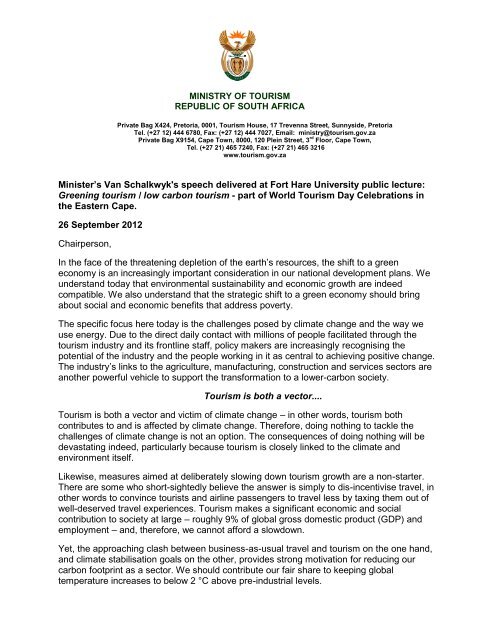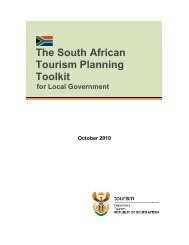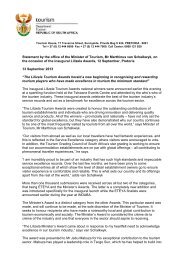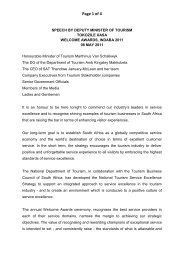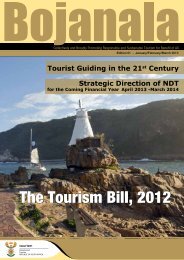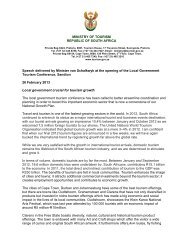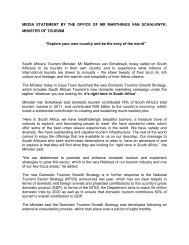Greening tourism / low carbon tourism - Department of Tourism
Greening tourism / low carbon tourism - Department of Tourism
Greening tourism / low carbon tourism - Department of Tourism
Create successful ePaper yourself
Turn your PDF publications into a flip-book with our unique Google optimized e-Paper software.
MINISTRY OF TOURISMREPUBLIC OF SOUTH AFRICAPrivate Bag X424, Pretoria, 0001, <strong>Tourism</strong> House, 17 Trevenna Street, Sunnyside, PretoriaTel. (+27 12) 444 6780, Fax: (+27 12) 444 7027, Email: ministry@<strong>tourism</strong>.gov.zaPrivate Bag X9154, Cape Town, 8000, 120 Plein Street, 3 rd Floor, Cape Town,Tel. (+27 21) 465 7240, Fax: (+27 21) 465 3216www.<strong>tourism</strong>.gov.zaMinister’s Van Schalkwyk's speech delivered at Fort Hare University public lecture:<strong>Greening</strong> <strong>tourism</strong> / <strong>low</strong> <strong>carbon</strong> <strong>tourism</strong> - part <strong>of</strong> World <strong>Tourism</strong> Day Celebrations inthe Eastern Cape.26 September 2012Chairperson,In the face <strong>of</strong> the threatening depletion <strong>of</strong> the earth’s resources, the shift to a greeneconomy is an increasingly important consideration in our national development plans. Weunderstand today that environmental sustainability and economic growth are indeedcompatible. We also understand that the strategic shift to a green economy should bringabout social and economic benefits that address poverty.The specific focus here today is the challenges posed by climate change and the way weuse energy. Due to the direct daily contact with millions <strong>of</strong> people facilitated through the<strong>tourism</strong> industry and its frontline staff, policy makers are increasingly recognising thepotential <strong>of</strong> the industry and the people working in it as central to achieving positive change.The industry’s links to the agriculture, manufacturing, construction and services sectors areanother powerful vehicle to support the transformation to a <strong>low</strong>er-<strong>carbon</strong> society.<strong>Tourism</strong> is both a vector....<strong>Tourism</strong> is both a vector and victim <strong>of</strong> climate change – in other words, <strong>tourism</strong> bothcontributes to and is affected by climate change. Therefore, doing nothing to tackle thechallenges <strong>of</strong> climate change is not an option. The consequences <strong>of</strong> doing nothing will bedevastating indeed, particularly because <strong>tourism</strong> is closely linked to the climate andenvironment itself.Likewise, measures aimed at deliberately s<strong>low</strong>ing down <strong>tourism</strong> growth are a non-starter.There are some who short-sightedly believe the answer is simply to dis-incentivise travel, inother words to convince tourists and airline passengers to travel less by taxing them out <strong>of</strong>well-deserved travel experiences. <strong>Tourism</strong> makes a significant economic and socialcontribution to society at large – roughly 9% <strong>of</strong> global gross domestic product (GDP) andemployment – and, therefore, we cannot afford a s<strong>low</strong>down.Yet, the approaching clash between business-as-usual travel and <strong>tourism</strong> on the one hand,and climate stabilisation goals on the other, provides strong motivation for reducing our<strong>carbon</strong> footprint as a sector. We should contribute our fair share to keeping globaltemperature increases to be<strong>low</strong> 2 °C above pre-industrial levels.
So, the key question is:....So, the key question is: How do we keep travel and <strong>tourism</strong>, but lose the <strong>carbon</strong>? How dowe de<strong>carbon</strong>ise? We know that, globally, about 40% <strong>of</strong> our sector’s emissions come fromair transport, and the rest from accommodation, at 21%; land transport, at 32%, and a smallpercentage from other <strong>tourism</strong> activities. If international tourist arrivals were to continuegrowing at its current pace, and we did nothing to de<strong>carbon</strong>ise, emissions from air transportalone will increase four-fold by 2050. If all economic sectors fol<strong>low</strong>ed this path, it will beimpossible to avoid dangerous climate change during this century.Fortunately, we also know that we have many options to reduce our sector’s <strong>carbon</strong>footprint.In the accommodation cluster, green building design, energy-efficiency measures andrenewable-energy deployment are priorities.In the land transport cluster, a shift in passengers’ preferred form <strong>of</strong> transport, more efficientvehicles and <strong>low</strong>-<strong>carbon</strong> fuels, as well as improved public transport in ‘green cities’,represent the most promising mitigation options.In the air transport cluster...In the air transport cluster, the most viable mitigation options for the next two decades aremainly related to the way in which we run our airports and planes, as well as technologydrivenefficiency improvements. However, in the long run, there are only two big gamechangers: firstly, the introduction <strong>of</strong> sustainable, or so-called second-generation, bi<strong>of</strong>uels asa substitute for kerosene jet fuel, and, secondly, the establishment <strong>of</strong> a market-basedmechanism such as a global emissions trading scheme. Such a scheme should limitemissions growth, while introducing a price incentive for those who stand ready to invest in<strong>low</strong>er-<strong>carbon</strong> jet fuels, infrastructure and technologies.A global emissions trading scheme will also create flexibility to <strong>of</strong>fset aviation’s unavoidableemissions with <strong>low</strong>er-cost <strong>carbon</strong> savings from other economic sectors – at least until wesucceed in curing aviation from its addiction to kerosene jet fuel.Chairperson, clearly, on its own or in isolation, the <strong>tourism</strong> sector can achieve only modestgains. We depend heavily on, for example, the de<strong>carbon</strong>isation <strong>of</strong> the country’s broaderenergy strategy, introducing more renewables; public transport planning; aviation planning;building codes, and other regulations enforced by sister departments.Very significantly...Very significantly, governments also control public infrastructure development, which couldact as catalysts for change, such as investment in public transport, airports, biodiversityconservation, renewable energy and water management.As part <strong>of</strong> our contribution, we, as the <strong>Tourism</strong> Ministry, recently introduced the NationalMinimum Standard for Responsible <strong>Tourism</strong>, which was ground-breaking if we look at whatis happening in the rest <strong>of</strong> the world.
But the challenge is about more than regulation. Those who think we can regulate andlegislate ourselves out <strong>of</strong> trouble, are missing the point. The greatest business incentive isto stay in business. Business needs to look beyond mere compliance, otherwise we will fail.And the pressure is mounting: Broadly speaking, pressure for change is coming from sixdirections:Multilateral negotiations on climate change,...i. Multilateral negotiations on climate change, which will mean that no industry orcountry would likely be able to escape its responsibilities after 2020ii. National/regional governments that introduce measures to implement the outcomes<strong>of</strong> multilateral negotiations, or take unilateral actioniii. Consumers who act largely out <strong>of</strong> moral conviction, and are increasingly willing topay a premium for more environmentally responsible or <strong>low</strong>-<strong>carbon</strong> <strong>tourism</strong> productsiv. Shareholders who increasingly see ‘<strong>low</strong>-<strong>carbon</strong>’ operations as critical to create valuefor themselvesv. Stakeholders in civil society, including the media, who are increasingly betterinformed and more vigilantvi. Internally, industry itself, lured by the <strong>low</strong>er operating costs associated with many<strong>low</strong>-<strong>carbon</strong> technologiesSo, what are the public policy tools...So, what are the public policy tools available to government?This is certainly not a history lesson, but it is nevertheless important to understand wherewe come from as global public policy makers.Governments have an increasingly wider range <strong>of</strong> policy tools at their disposal to addressmarket failures in pursuit <strong>of</strong> environmental goals. None <strong>of</strong> the major environmental crisestoday can be addressed by using a single tool – at least, not if we want to do so in anenvironmentally effective and cost-efficient manner.It is useless to get stuck in outdated ideological debates about markets versus regulation.To achieve our goals, we need a combination <strong>of</strong> policy tools.A couple <strong>of</strong> decades ago, there was a misplaced belief in top-down, command-and-controltyperegulation – government using the stick. It was regarded as the magic cure for allenvironmental problems. But soon, policy makers realised that it involved ‘hidden’ economiccosts.Then, in the 1970s...Then, in the 1970s, the pendulum worldwide swung away from regulation towards marketbasedinstruments. Especially since the late 1980s, market or incentive-based tools havemultiplied and are <strong>of</strong>ten used in combination with information-based approaches.Essentially, today, there are three categories <strong>of</strong> policy tools available to governments: (i)information-based approaches, which try to raise awareness; (ii) incentive-basedapproaches, which facilitate (and not enforce) change by using the market or othereconomic instruments, and (iii) directive-based approaches, which are blunt policyinstruments that call for specific behaviour.


